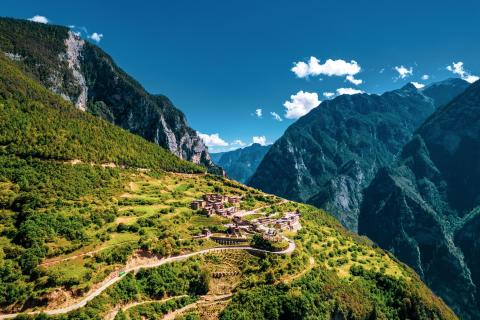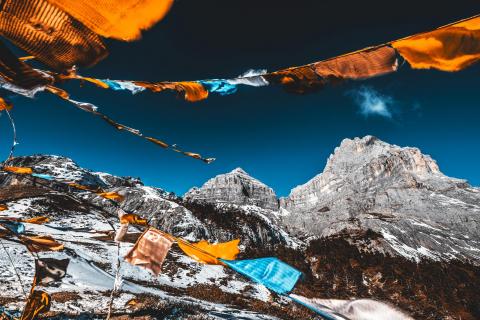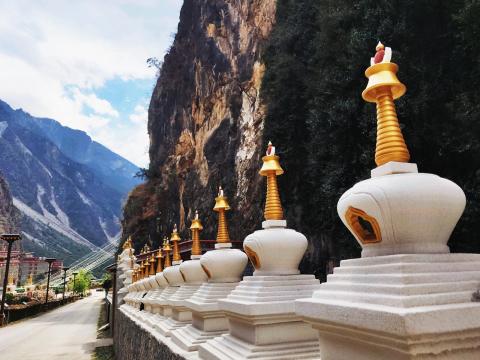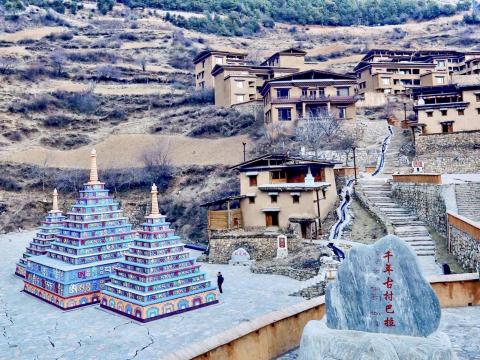Bala Gezong Snow Mountain, with an elevation of 5,545 metres, is the highest snow mountain in Shangri-La. It stands on the bank of Jinsha River and, together with the opposite Baimang Snow Mountain with an elevation of 5,640 metres, forms a gorge as good as the Tiger Leaping Gorge.
These four mountains and two gorges face each other with the yak plateau in the middle, making Shangri-La a relatively independent geographical unit.

The east gate into Shangri-La is the Lower Bridge Head, and the west gate is the Upper Bridge Head. The Shuodugang River in the east divides the Haba Snow Mountain and there’s also a river in the west that goes through the Bala Gezong Snow Mountain.
"Gangqu," with a literal meaning of a river originating from snow mountain, originates from the Shangri-La Snow Mountain, and runs into the Jinsha River through the Upper Bridge Head.
People go through the Upper Bridge Head which is the only gateway to Tibet and Sichuan, and pass through Deqin County to Tibet, then go up along Gangqu and cross the narrow pass for Bala Gezong, arrive Derong County of Sichuan, then go for Batang County. Once in the Long March, the Second Front Army fought a battle at the Upper Bridge Head, that's why there is a Red Army Bridge on the Gangqu River.
"Bala" literally means "coming from Batang", and "Gezong" literally means "white castle." The nature gives birth to the endless beauty surrounding this sacred snow mountain.
Pear flower in spring, green grass in summer, myriad colours in autumn, frozen land and sunshine in winter. Besides the four-season scenery, at the foot of Bala Gezong Snow Mountain, there is the unceasingly running Gangqu River and unique gorge and precipice, as well as the dry heat river valley landscape resembling tropical African Savannah.
On the mountainside, there is thick virgin forest as well as various rare birds and beasts and exotic plants, and on the mountain top, there is a lofty snowy peak glacier and ice lake.
There’s high mountain shrub meadow with high mountain flowers and plants and rare Chinese herbal medicine, and flowing stone beach landscape. All this scenery is common to see throughout the year in the Bala Gezong Ecotourism Scenic Area.

Shangri-La Grand Canyon Plateau Lake
Walking into the Bala Gezong Canyon, the most striking thing is the water of Gangqu River, which could be the clearest water in the world.
The river flows from the Upper Bridge Head. There are no villages along the riverside, and no industrial pollution. It runs sometimes rapidly, sometimes gently, in a bending curve along the canyon.
Both precipices of the canyon extend at 90° upwards, it’s difficult to know exactly what the height is, but it’s no less than 1,000 metres.
The highway is on the west bank, and the ancient road is on the east bank, pity there is no horse caravan now, thus no melodious tinkle of bells be heard. A few years back, life of the Bala villagers at the foot of the snow mountain depended on the ancient road, it is said that none of them had gone beyond this paradise land, none of them had seen a car.

Stepping on the tourist plank road over the canyon, seeing cliffs upwards and downwards, you may feel a little uneasy and slightly soft on your feet.Out of the canyon are the virgin forests, then the high mountain pastures, and finally the pure white snow peak.
Every year, in late spring and early summer, various rhododendron blossom in clusters to embellish the snow mountain and green water, forming a beautiful picture scroll.
While in bright and crisp fall days, there are row upon row of trees, red-coloured mountains from top to toe, and cattle and sheep taking leisure and carefree walks on the grassland. All making for colourful autumn scenery.
If you want to see the top of Bala Gezong Snow Mountain, you need to go a further 9km from the Bala Village. The snow peaks there are composed of Danxia landform and are spectacular. Together with the natural pagoda partly visible between the cloud and mist, this is like a fairyland.

Bala Gezong Snow Mountain is a holy land for Tibetan Buddhism, and there’s only been one village throughout a thousand years. That is Bala Village, which literally means "Tibetan village from Batang.”
Legends say that long, long ago, one of King Gesar's senior generals, who was tired of perennial and constant wars, dreamed that one day three fairies would bring him to a fairyland-like canyon with no wars and worries.
The next day, he talked about his beautiful dream to his Buddha tutor. The tutor said that it was the order from the snow mountain god, and that it was expected to seek a harmonious and peaceful homeland.
So, the senior general led his family and troop to seek out the homeland in his dream. It took them eighty-one days in the Kangba Tibetan region. One day in the late night they climbed over the Bengbogang Gezong Snow Mountain, they were out of food and lack of water, they were exhausted and they fainted on the ground.
The next day, when they woke up in the morning, the sight in front of their eyes surprised them, the place was encircled by mountains and remote from earth and beside a river, it was exactly what they were seeking, the ideal homeland, the Gezong (white castle) Snow Mountain in the dream.
They settled down in this place. As the family of were from Batang, they named the place Bala Village, and the snow mountain behind the village was named as Bala Gezong Snow Mountain.
For hundreds and thousands of years, they arranged daily life upon sunrise and sunset, lived a "paradise" life secluded from the world. Tibetan houses of different sizes scattered and organised on this land, the warming morning light adds quietness and peace to this land.
Tibetan folk customs make the spirit of this scenic area, which later became the Shangri-La Grand Canyon in the writings of the famous British writer James Hilton during the 20th century.

